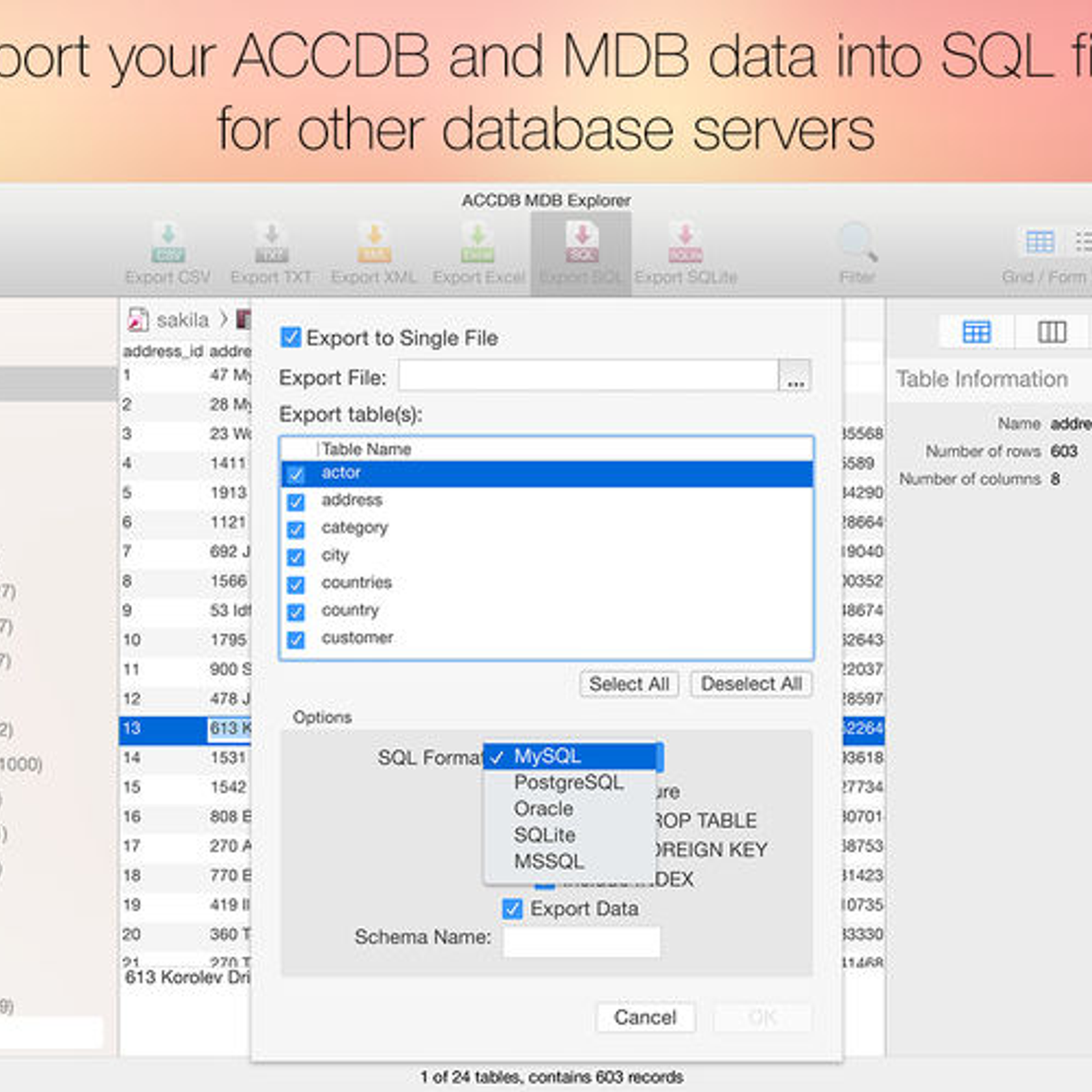ACCDB MDB Explorer 2.4.7 Crack Mac is a tool designed to provide a quick and easy way to view MDB files without an Access license. This application can be used to open tables from multiple access databases, with the table structure described in the form of columns and relationships.
It will only connect to a.mdb database. I am using Visual Studio 2015 Community. I have added references in my project to Microsoft.Office.Core and Microsoft.Office.Interop.Access.Dao to my VB.Net project. If instead of using a.accdb database with my application, I substitute an.mdb database with the same name, my code works fine. . Support mdb and accdb MS Access database format. Build-in file explorer to find database files on your Android Device. Open Database from Dropbox, Email Attachment and other File Explorer/File Manager. Share/Send database file via email or Dropbox. View table data with paging list. ACCDB files can be opened with Microsoft Access (version 2007 and newer). Microsoft Excel will import ACCDB files but that data will then have to be saved in some other spreadsheet format. The free MDB Viewer Plus program can also open and edit ACCDB files. This is a great alternative if you don't have a copy of Access.
If you have got a database that was create a long time ago, it is most likely in one of the old Access .MDB file formats. Now you want to convert this database to the newer .accdb file format of Access 2007 and later. Of course, you want to keep the existing history of the project, so it is not an option to just convert a local copy of the database and add that copy to a new repository folder.
Fortunately, it is absolutely possible to convert the database and preserve the full history of your project.
However, this process does require some manual work. This document lists the necessary steps for a successful conversion.
If you prefer a video over the text based list of steps please scroll to the end of this article. There is a video embed showing the process.
Database file format conversion - Step by Step
Make sure there are no objects currently checked out. The repository should contain all changes you want to keep.
That does include all other members of your team. You should have exclusive access to the repository during the conversion. This takes only a few minutes.
It is recommended to apply a label to the repository folder with a meaningful name like “Before MDB to ACCDB conversion”. - This is optional, though.
Start the client application for your source code control system. For Microsoft Team Foundation Server that is Visual Studio / Team Explorer. The process works all the same with any other source code control system.
Use the client application to connect to your source code control repository browse to the repository folder containing your Access database project.
Find the file yourDatabase.acb and use the SCC-Client to rename this file to yourDatabase.acd. Depending on your SCC-System you need to explicitly commit/check-in this rename operation.
Get the Latest Version of this renamed file and check-out this file to your local working folder. That usually is the yourDatabase_IvercyTmp folder on your local disk.
Open the local working folder containing this file on disk in Windows Explorer.
Check if there is a file yourDatabase.mdb in this folder already. If yes, then please delete this file.
Rename the local file yourDatabase.acd to yourDatabase.mdb.
Open this .mdb file in Microsoft Access. This an (almost) empty database with nothing in there. This is as expected.
In Access, go to the File-Tab in the Ribbon, select the Save & Publish-Tab there, and then click the Save As-Button. Save the database to the same folder using the same name, but with the .accdb file extenstion.
You should see a message saying that this database was upgraded to Access 2007 file format.
Then close Microsoft Access.
Go back to the local folder in Windows Explorer. In this folder there should be a file yourDatabase.mdb and yourDatabase.accdb now.
Delete the file yourDatabase.mdb.
Rename the file yourDatabase.accdb to yourDatabase.acd.
Go back to your SCC-Client-Application and check-in the file yourDatabase.acd.
Now, in the repository folder, look for a file named yourDatabase.acx.
This file will only exist if the database was added using the Microsoft source code control Plug-In for Access.
- Check-out this file.
- Open the file using any text editor
- Find the DBVersionToCreate-Tag in the XML of the file
- Change the value of the tag from sccFileFormatAccessMDB2010 to sccFileFormatAccess2010.
- Save the file and check-in the file using the SCC-Client application.
Go to Windows Explorer, browse to folder containing your local copy of the database and delete the yourDatabase.mdb file and the yourDatabase_IvercyTmp folder.
Rename the file yourDatabase_IvercyConfig.xml to yourDatabase_IvercyConfig.xml.bac. - This is to preserve any Ivercy settings for this local copy. If your database just uses your default settings, you can skip this.
Start Access and create a fresh, local copy of your database from the SCC-Repository using the same working folder as before.
Close Access.
If you backed up your Ivercy settings in Step 14 delete the newly created yourDatabase_IvercyConfig.xml file and rename the old yourDatabase_IvercyConfig.xml.bac back to yourDatabase_IvercyConfig.xml.
Congratulations! - You are done! You can now continue to work with your newly converted database.

Other team members working on the same database should create a fresh local copy of the database as well (Step 14 to 17).


Accdb Mdb Explorer 2019
You can use this guide even if you are still using the Microsoft source code control Plug-In for Access. It works all the same.
Which Is Better Mdb Or Accdb
For your convenience we recorded a video of the process showing all the steps outline above.